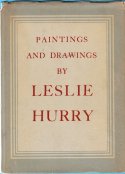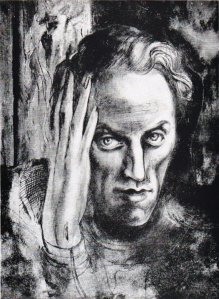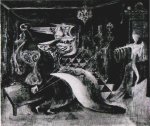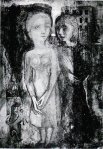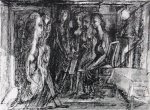Still some weeks to the precise centenary of the outbreak of war, though in telly terms we seem to have been in the trenches for a considerable time already. This may be a quick, cheap post, but last time’s woodcut by David Jones brings to mind his panoramic book length poem In Parenthesis, which to my mind has to stand as the single finest poetic response in the English language to the experience of that conflict.
More of that in a moment, but for the equivalent finest British painting – Lewis, Nash, Nevinson and others notwithstanding – I’d take a step back from modernism and go for Eric Kennington‘s haunting The Kensingtons at Laventie, which shows the painter himself (the left of the two faces in balaclavas) and his comrades at a stilled moment of exhaustion.

It’s a big piece, and painted on glass, so that with Kennington standing behind his “canvas” the tiniest of details were put in first, working back progressively to the larger areas of colour. Though in itself that doesn’t necessarily make for virtue, you have to admire his technical wizardry – how the hell did he do it? However it was done, the effect is to dislocate and flatten the already limited perspective in a manner reminiscent of Uccello, heightening painfully the luminous physical presence of the figures and of the curiously graceful debris that surrounds them. Like In Parenthesis, Kennington’s painting presents the sufferings of the ordinary soldier at a sacramental pitch.

Though Kennington, wearing his sculptor’s hat, later went in for some sub-Epstein direct carving, it always came out a bit cartooney, as if he didn’t really get modernism. It’s for his portraits of servicemen that he is still known, and this – being not yet the propaganda that he later turned out effortlessly – has to be the best.
Jones’s In Parenthesis was published two decades after the events it describes. It is both claustrophobic and epic, collaging immediate physicalities with the music hall slang of the common soldier, the bitterly bland voice of the official communiqué, or the ancient histories that Jones finds echoed in current events – whether in an Arthurian dimension or as a reminder of the soldiery who witnessed the Crucifixion. Despite the extensive footnoting required by such allusiveness, the book remains intensely readable. Here is a typical enough passage, describing the emptiness before the advance, the shelled landscape populated only by stretcher bearers and their burdens, by a lone Forward Observation Officer, and by the engineers who creep out to repair his line:
Carrying-parties,
runners who hasten singly,
burdened bearers walk with careful feet
to jolt him as little as possible,
bearers of burdens to and from
stumble oftener, notice the lessening light,
and feel their way with more sensitive feet –
you mustn’t spill the precious fragments, for perhaps these raw bones live.
They can cover him again with skin – in their candid coats, in their clinical shrines and parade the miraculi.
The blinded one with the artificial guts – his morbid neurosis retards the treatment, otherwise he’s bonza – and will learn a handicraft.
Nothing is impossible nowadays my dear if only we can get the poor bleeder through the barrage and they take just as much trouble with the ordinary soldiers you know and essential-service academicians can match the natural hue and everything extraordinarily well.
Give them glass eyes to see
and synthetic spare parts to walk in the Triumphs, without anyone feeling awkward and O, O, O, it’s a lovely war with poppies on the up-platform for a perpetual memorial of his body.
Lift gently Dai, gentleness befits his gun-shot wound in the lower bowel – go easy – easee at the slope – and mind him – wait for this one and
slippy – an’ twelve inch an’ all – beating up for his counter-attack and – that packet on the Aid-Post.
Lower you lower you – some old cows have malhanded little bleeders for a mother’s son.
Lower you lower you prize Maria Hunt, an’ gammyfingered uplands Gamalin – down cantcher – low – hands away me ducky – down on hands on hands down and flattened belly and face pressed and curroodle mother earth
she’s kind:
Pray her hide you in her deeps
she’s only refuge against
this ferocious pursuer
terribly questing.
Maiden of the digged places
let our cry come unto thee.
Mam, moder, mother of me.
Mother of Christ under the tree
reduce our dimensional vulnerability to the minimum –
cover the spines of us
let us creep back dark-bellied where he can’t see
don’t let it.
There, there, it can’t, won’t hurt – nothing
shall harm my beautiful.
But on its screaming passage
their numbers writ
and stout canvas tatters drop as if they’d salvoed grape to the mizzen-sheets and the shaped ash grip rocket-sticks out of the evening sky right back by Bright Trench
and clots and a twisted clout
on the bowed back of the F.O.O. bent to his instrument.
… theirs … H.E. … fairly, fifty yards to my front … he’s bumping the Quadrangle … 2025 hours? – thanks – nicely … X 29 b 2 5 … 10.5 cm. gun … 35 degrees left … he’s definitely livening.
and then the next packet – and Major Knacksbull blames the unresponsive wire.
And linesmen go out from his presence to seek, and make whole with adhesive tape, tweezer the copper with deft hands: there’s a bad break on the Bright Trench line – buzz us when you’re through.
And the storm rises higher
and all who do their business in the valley
do it quickly
and up in the night-shades
where death is closer packed
in the tangled avenues
fair Balder falleth everywhere
and thunder-besom breakings
bright the wood
and a Golden Bough for Johnny and Jack
and blasted oaks for Jerry
and shrapnel the swift Jupiter for each expectant tree;
after what hypostases uniting:
withered limbs for the chosen
for the fore-chosen.
Take care the black brush-fall
in the night rides
where they deploy for the final objective.
Dark baulks sundered, bear down,
beat down, ahurtle through the fractured growings green,
pile high an heaped diversity.
Brast, break, bough-break the backs of them,
every bone of the white wounded who wait patiently –
looking towards that hope:
for the feet of the carriers long coming
bringing palanquins
to spread worshipful beds for heroes.
You can hear him,
suppliant, under his bowery smother
but who can you get to lift him away
lift him away
a half-platoon can’t.
How many mortal men
to bear the Acorn-Sprite –
She’s got long Tom
and Major Lillywhite,
they’re jelly-bags with the weight of it:
and they’ll carry out Deth tomorrow.
There are indications that the enemy maintains his positions north-east of the central-ride. At 21.35 hrs units concerned will move forward and clear his area of his personnel. There will be adequate artillery support.
 Jones was slid in among the “war poets” at Poets’ Corner in Westminster Abbey, where, like Aldington or Read, he hardly seems a good fit, given that he was so much more than just a war poet.
Jones was slid in among the “war poets” at Poets’ Corner in Westminster Abbey, where, like Aldington or Read, he hardly seems a good fit, given that he was so much more than just a war poet.


































